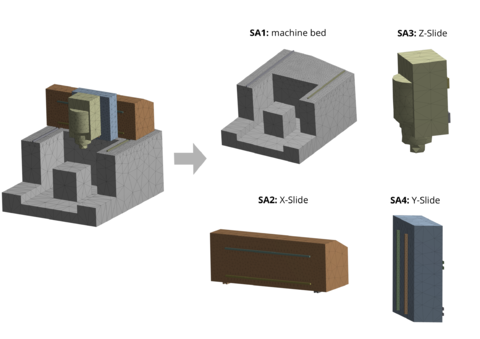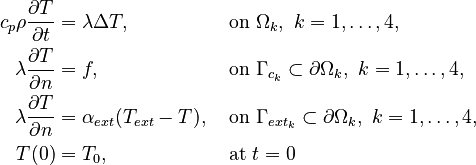| Background | |
|---|---|
| Benchmark ID |
|
| Category |
CRC-TR-96 |
| System-Class |
LTI-FOS |
| Parameters | |
| nstates |
|
| ninputs |
|
| noutputs |
|
| nparameters |
0 |
| components |
A, B, C, E |
| Copyright | |
| License |
Creative Commons Attribution 4.0 International |
| Creator |
|
| Editor | |
| Location | |
1 Motivation
Due to the increasing interest in manufacturing accuracy without an additional energy demand for cooling, knowledge about the thermo-elastic behavior of entire machine tools becomes crucial. Methods to correct the thermally induced position error between the tool-center-point (TCP) and the workpiece in real-time are needed. Therefore, reduced-order models that enable a fast simulation of entire machine tools are applied in the design and production process.
2 Description
The simplified machine tool benchmark is a linear time-invariant thermal model used for investigation and demonstration purposes in the CRC/TR 96. For more information on first numerical experiments, see [1]. It is divided into four stationary subassemblies (SA): machine bed, X-slide, Z-slide, Y-slide, see Fig. 1. The thermal finite element (FE) model was generated in ANSYS and afterwards the FE system matrices were exported for post-processing, such as MOR, to MATLAB. The interaction between the subassemblies is modeled by contact boundary conditions. In this case an input-output coupling was used, i.e., the model is block diagonal and thus the subassemly models can be reduced separately for structure preserving MOR. The evolution of the temperature field is modeled by the heat equation
with
and

- number of the subassembly, 

- temperature 
- specific heat capacity 
- density 
- heat conductivity 
- domain of the k-th subassembly 
- contact boundary of the k-th subassembly (partly time varying, moves with the position of the z-slide (considered as heat flow)) 
- heat transfer coefficient between a subassembly and the ambient air 
- external temperature 
- contact boundary with the ambience 
- friction driven heat flow induced by the movement 
- heat transfer coefficient between two subassemblies 
- temperature of the contact area of subassembly k.
The finite element discretization of the heat conduction models leads to the four systems
with

- capacity matrix 
- conductivity matrix 
- discrete temperature 
- input map 
- input vector 
- output vector 
- output map.
3 Data
The system matrices can be downloaded from zenodo. There is a set of matrices for each subassembly. The numbering of the subassemblies is shown in Fig. 1. The model is available in two versions: a fine discretization with  degrees of freedom and a coarse discretization with an overall system dimension of
degrees of freedom and a coarse discretization with an overall system dimension of  . The dimensions of the subassemblies of both models can be seen in the following table:
. The dimensions of the subassemblies of both models can be seen in the following table:
| Model | Subassembly 
|

|

|

|
| fine | 1 | 
|

|

|
| 2 | 
|

|

| |
| 3 | 
|

|

| |
| 4 | 
|

|

| |
| coarse | 1 | 
|

|

|
| 2 | 
|

|

| |
| 3 | 
|

|

| |
| 4 | 
|

|

|
4 Origin
The simplified machine tool model was developed in the CRC/TR 96 Project-ID 174223256 financed by the German Research Foundation DFG.
5 Citation
To cite this benchmark, use the following references:
- For the benchmark itself and its data:
@misc{dataSauNVetal23,
author = {S. Sauerzapf and A. Naumann and J. Vettermann and J. Saak},
title = {Matrices for a simplified machine tool model},
howpublished = {hosted at {MORwiki} -- Model Order Reduction Wiki},
year = 2023,
doi = {10.5281/zenodo.10017861}
}
- For the background on the benchmark:
@inproceedings{SauVNetal20,
author = {Sauerzapf, S. and Vettermann, J. and Naumann, A. and Saak, J. and Beitelschmidt, M. and Benner, P.},
title = {Simulation of the thermal behavior of machine tools for efficient machine development and
online correction of the {Tool} {Center} {Point} ({TCP})-displacement},
booktitle = {Conference Proceedings on Thermal Issues, Aachen, 26-27 February},
organization = {euspen},
pages = {135--138},
year = {2020},
url = {https://www.euspen.eu/knowledge-base/TI20125.pdf }
}
6 References
- ↑ S. Sauerzapf, J. Vettermann, A. Naumann, J. Saak, M. Beitelschmidt and P. Benner, "Simulation of the thermal behavior of machine tools for efficient machine development and online correction of the Tool Center Point (TCP)-displacement", Conference Proceedings on Thermal Issues, Aachen, 26-27 February, pp. 135–138, euspen, 2020.




